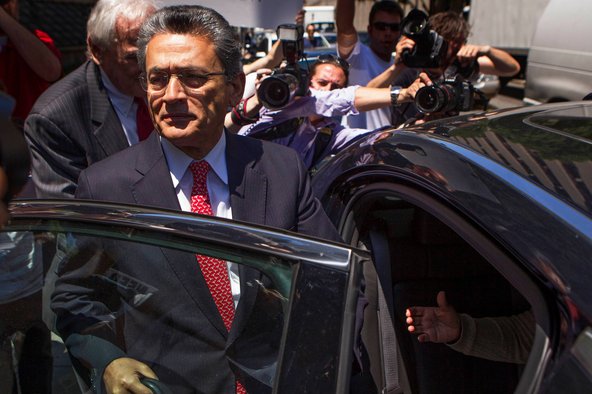 Jeff Robbins/Associated PressDoug DeCinces of the Callifornia Angels in 1987. The all-star third baseman was indicted on insider trading charges.
Jeff Robbins/Associated PressDoug DeCinces of the Callifornia Angels in 1987. The all-star third baseman was indicted on insider trading charges.
The end of November included a veritable rush of insider trading prosecutions, belying the notion that the government goes on hiatus at the end of the year.
Three cases filed by prosecutors in Manhattan, Los Angeles and New Jersey involve defendants from a variety of backgrounds. The cases illustrate that insider trading can involve those in all walks of life, and not just savvy traders. They include:
- A former portfolio manager at a leading hedge fund firm in the most lucrative insider trading case ever charged;
- A former major league baseball player accused of insider trading as well as tipping off three friends to make up for poor investment advice he had given them earlier;
- A web of six defendants that includes a group of high school buddies who are accused of passing along information while playing basketball.
White Collar Watch
View all posts
Interestingly, none of the cases involved the use of wiretaps to capture how the information was disclosed, evidence that was a central feature of other high-profile insider trading prosecutions in the last two years.
The case that has grabbed the most attention is the prosecution of Mathew Martoma, who worked as a portfolio manager at SAC Capital Advisors, the $14 billion hedge fund firm controlled by Steven A. Cohen. Mr. Martoma is accused of receiving information about problems in a clinical drug trial conducted by Elan and Wyeth that led the hedge fund to sell out its $700 million position in the companies and then take a bearish position, all in the matter of a few days.
According to prosecutors, that led SAC Capital to make gains and avoid losses totaling $276 million, dwarfing the $63 million reaped by Raj Rajaratnam, who is serving an 11-year prison term following his convictions in 2011 for insider trading.
Mr. Cohen and SAC Capital have denied any involvement in trading on confidential information. In a recent conference call with investors, Mr. Cohen said, “We take these matters very seriously, and I am confident that I acted appropriately.”
The firm also disclosed that the Securities and Exchange Commission had sent it a so-called Wells notice that its staff is considering filing civil charges based on the illegal trading by Mr. Martoma and perhaps others. This would not directly accuse the firm of engaging in insider trading, but instead claim that SAC Capital failed to properly oversee its employees.
An obscure provision of a federal statute adopted in 1988 allows the S.E.C. to seek a triple penalty for any profits or losses avoided when a “controlling person” knowingly or recklessly fails “to establish, maintain, or enforce any policy or procedure” against insider trading. Under this provision, even if Mr. Cohen and other SAC Capital executives were not personally aware of insider trading by portfolio managers, turning a blind eye to it could be enough to expose the firm to substantial liability.
In another case, federal prosecutors in Los Angeles filed charges late last month against a former major league baseball player, Douglas V. DeCinces, and three men that he is accused of tipping about the impending acquisition of Advanced Medical Optics. The government claims he received the inside information from the company’s chief executive and passed it on to make up for “prior bad investment recommendations” while also earning approximately $1.3 million himself.
This is a case in which it is — pardon the cliché — a little hard to follow the players without a scorecard. Mr. DeCinces and two of his co-defendants settled similar S.E.C. civil charges in August 2011, which indicated that the case was likely to be over for them. In August 2012, the S.E.C. charged Advanced Medical Optics’ chief executive, James V. Mazzo, and the third person who is said to have received information from Mr. DeCinces. Another defendant in that case was a baseball Hall of Fame member, Eddie C. Murray, a former teammate of Mr. DeCinces’s on the Baltimore Orioles, who settled the charges.
The indictment does not contain allegations different from the S.E.C.’s civil case, and it is unclear why prosecutors waited more than a year to pursue criminal charges against Mr. DeCinces and others. But Mr. Mazzo is not named as a defendant in the criminal case, only identified in the indictment as the “source.” And while three recipients of the tips are charged in the latest indictment, Mr. Murray is not one of them.
An interesting question is whether Mr. Mazzo is cooperating with the government in exchange for a reduced sentence. The typical insider trading case involves charges against the tipper because that is the person responsible for the violation (though there have been exceptions, like in case involving Mr. Martoma of SAC Capital).
Proving a case against a recipient is difficult without the cooperation of the tipper, unless there are wiretaps or other evidence to show how the information was passed. Prosecutors could add Mr. Mazzo as a defendant later, but not including him now is puzzling because the S.E.C. civil complaints have virtually all the information recited in the indictment.
One possibility is that prosecutors hope to use Mr. Mazzo against Mr. DeCinces and the others if a plea agreement can be worked out. Another possibility is a different cooperating witness can provide evidence of how the inside information was passed around, and prosecutors are waiting to see whether Mr. Mazzo will cut a deal before moving against him.
Another case of note involves six defendants who are accused of creating a web of inside information about pharmaceutical companies. They are accused of obtaining information from three who worked for firms in the industry. Unlike the other two insider trading prosecutions, this was not a one-time event but a scheme to break the law over nearly four years by using secret code names and passing along cash payments to the sources to avoid detection.
The defendants sought to hide their actions by saying things like “how’s the Fat Man doing?” to refer to the inside information and setting up meetings to make cash payments with “I have some vacation pictures for you.” One defendant is accused of putting together a research file to try to cover the group’s actions. In testimony in an S.E.C. investigation about some of the trading, he denied knowing anyone at one of the pharmaceutical companies.
A conspiracy like this is dependent on each participant keeping a wall of silence. Unfortunately, the criminal complaint describes a conversation in September with a cooperating witness in which one defendant boasted that investigators would not be able to be able “to link everybody up” because they were careful.
Given the number of defendants and unindicted co-conspirators who traded and how long the scheme lasted, the gains were surprisingly low, totaling less than $1.5 million. The defendants may have hoped to avoid detection by keeping the trades small, but in the end someone turned on them.
All three cases involve very disparate means of obtaining information and vastly different sums at stake. But they all indicate that the government is not letting up on its aggressive stance in pursuing both criminal and civil insider trading cases, even when they don’t have wiretap evidence.
Article source: http://dealbook.nytimes.com/2012/12/03/string-of-insider-trading-cases-shows-prosecutors-casting-a-wider-net/?partner=rss&emc=rss









